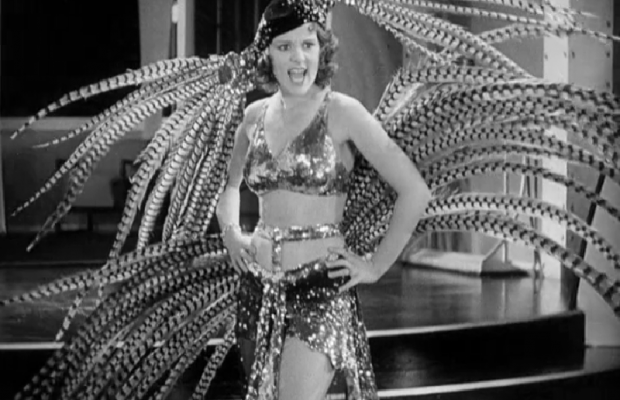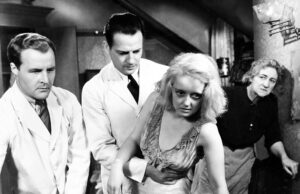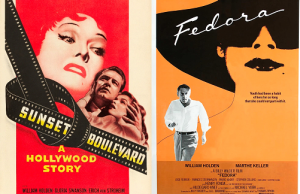Madam Satan (1930)

Toronto Film Society presented Madam Satan on Friday, May 10, 2013 as part of Season 66 May Festival: The Pre-Code Weekend.
Many years ago, most probably up at the Briars, and probably brought by Bill Everson, we saw an excerpt from this film that filled me with awe. The film seemed surreal and a bit crazy and made you even wonder what it could have been about. There were beautiful people dressed in outrageous costumes, there was something sci-fi going on in one of the rooms at a party in a Zeppelin (do Zeppelin’s have rooms?), which brought Flash Gordon immediately to mind. So just with that bit of image, it was a life’s quest to see this film. Is it a good film? A lot of reviews tell you what’s wrong with it. But is it a film worth seeing? You bet!
Also noteworthy is that this is one of the very few films that features the eminent Lillian Roth. Susan Hayward was nominated for an Academy Award for her portrayal of the turbulent life of Lillian in the 1955 bio-film I’ll Cry Tomorrow.
Caren Feldman, May 10, 2013
At the beginning of every decade there seems to be some sort of overconfidence in what lies ahead. I remember when the 70’s turned into the 80’s everyone was talking about ”Big Brother” and that  the dystopia of George Orwell’s book soon was to become reality. On top of that computers were soon to take over our lives completely. What I want to say is that the beginning of a new decade always is looked upon as something magic and that almost every aspect of our existence soon has to go through some sort of catharsis just because of this detail.
the dystopia of George Orwell’s book soon was to become reality. On top of that computers were soon to take over our lives completely. What I want to say is that the beginning of a new decade always is looked upon as something magic and that almost every aspect of our existence soon has to go through some sort of catharsis just because of this detail.
I figure they must have experienced the same thing back in the days. Maybe that’s why there were quite a few really strange pictures made in the magic year of 1930. All of a sudden there was a need to prove the 1920’s was over, and not with a whimper. Naturally I think of Fox’s Sci-Fi musical Just Imagine and why not Warner’s almost insane musical Golden Dawn. It seems almost every studio had a really weird picture out this year. Naturally, fairly conservative studio MGM didn’t want to be less spectacular than the others, and with a million dollar budget and a really big director they felt sure to stir things up.
Let’s have a look at Madam Satan, as it’s quite significant for the weirdness of 1930. Cecil B. DeMille had made his name at Paramount with biblical epics like The Ten Commandments and The King Of Kings. Brought over to MGM in 1929, he was given almost complete artistic freedom. Madam Satan is his second film at MGM and his first and last attempt ever at musicals. The writing credits goes to the all female screenwriting team of Jeanie Macpherson, Elsie Janis and Gladys Unger. Wonderful deco sets by Cedric Gibbons and fantastic gowns by Adrian. Madam Satan is in fact more of a musical drama than a full blood musical and it contains very few memorable songs apart from Lillian Roth’s peppy rendition of Low Down shown in an earlier post.
Madam Satan sets out as a bedroom farce with a lot of slamming doors and hiding under beds, and as such it’s quite amusing. The story circles around the marital problems of an upper class couple. Lovelorn housewife Angela Brooks is losing the love of her husband, Bob to a wild young showgirl named Trixie. While Angela is like a bird in a cage Bob lives a double life with Trixie downtown. However, Angela has a plan to win back her husband’s affections by taking on the personality of the mysterious “Madame Satan”.
We are now halfway into the movie. Suddenly everything turns in to futuristic operetta. At a magnificent masquerade ball given aboard a giant dirigible, Angela entrances her husband by her modish  vamping, amidst a spectacular electrical ballet in which characters simulate everything from sparkplugs to lightning bolts. Hidden behind her mask, and wrapped in an alluring gown, Angela as the devil woman will to try to seduce her unknowing husband and teach him a lesson.
vamping, amidst a spectacular electrical ballet in which characters simulate everything from sparkplugs to lightning bolts. Hidden behind her mask, and wrapped in an alluring gown, Angela as the devil woman will to try to seduce her unknowing husband and teach him a lesson.
After she has successfully ensnared him, the dirigible is struck by lightning, and the guests are forced to parachute from the ship. The movie now takes a new turn and all of a sudden there’s a lot of commotion. The catastrophe segment also contains some of the best special effects I have ever seen in a film this old. After Angela gives her parachute to the distraught Trixie, Bob, realizing his love for Angela, gives her his parachute and dives from the ship, suffering only minor injuries by landing in the Central Park reservoir. Husband and wife are blissfully reunited.
The bizarre mix of all the above ingredients makes it quite difficult to say if Madam Satan is a good picture or not as there is nothing to compare it with. It’s grandiose, high budget melodrama but as such it often misses the point. DeMille favorite Kay Johnson doesn’t convince as Madam Satan. DeMille uses too much of everything just because he can. There are great moments, some good dialogue and funny situations but they are just raisins in a too heavy cake. Its clear DeMille wanted to distance himself from the kind of movies he normally did but here he’s too far out on a limb.
Rumors say that many musical numbers were cut from the movie before release and that it originally included several production numbers shot in color. I don’t think this is true. There were some songs that didn’t make it to the final product. Color scenes may have been planned, but I believe they were never shot. If they were, they were never included in the picture at any point or even shown in public. The film couldn’t possibly have run much longer than the 116 minutes of the surviving print so I believe the Madam Satan we have today pretty much is the same picture that went up in September 1930.
A curiosity perhaps, but in almost every DeMille picture there is at least one luxurious bath scene. One could easily say he had a bath-fetish. Madam Satan starts out with a caged bird taking a bath and ends up with a swim in the Central Park reservoir so I think its right to say he wanted to try new paths (or tubs) before going back to Paramount and bath scenes of more biblical proportions.
http://www.talkieking.blogspot.ca/ ALL TALKING! ALL SINGING! ALL DANCING! by Jonas Nordin, November 20, 2008
First, an important warning! The first third of the film, though it is amusing and may well come to life before an audience, is quite incredibly arch. DeMille, trying to step into Lubitsch’s shoes, finds them much too big. Instead of ballet shoes he is wearing clogs, and the one element that this part of the film has to have to work—namely grace—it just doesn’t have. But don’t feel you have been lured  or betrayed; once aboard the Zeppelin, the whole pace and mood changes, and it becomes the kind of wild, vulgar, spectacular, no-holds-barred frolic that all deMille films are supposed to be and almost never are. Whether it is legitimately a “thriller” is something else again; its plot is a wild mélange that incorporates elements from “Die Fledermaus” and “The Guardsman”, and it could equally logically be termed sex farce, operetta, musical or fantasy. James Whale wouldn’t be ashamed of it—nor would Georges Melies. Certainly the climactic sequence of the runaway, collapsing dirigible is authentic “thriller”—but by that time you’ll all have had too much fun, and too much exposure to modern pop-art culture of 1930, to want to quibble. The sets, the costumes, the girls, the dialogue, all are quite dazzling. The one element of the film that comes off with genuine dignity and that hasn’t dated one whit is the serene and lovely performance from Kay Johnson, who also has one of the screen’s greatest curtain-exit lines: “I’ll make him so sick of vice he’ll scream for decency”! Incidentally DeMille’s voice can be heard as the radio announcer in the closing reel. Culturally, this may be one of the worst films we’ve played—but it’s certainly also one of the most entertaining and most unique.
or betrayed; once aboard the Zeppelin, the whole pace and mood changes, and it becomes the kind of wild, vulgar, spectacular, no-holds-barred frolic that all deMille films are supposed to be and almost never are. Whether it is legitimately a “thriller” is something else again; its plot is a wild mélange that incorporates elements from “Die Fledermaus” and “The Guardsman”, and it could equally logically be termed sex farce, operetta, musical or fantasy. James Whale wouldn’t be ashamed of it—nor would Georges Melies. Certainly the climactic sequence of the runaway, collapsing dirigible is authentic “thriller”—but by that time you’ll all have had too much fun, and too much exposure to modern pop-art culture of 1930, to want to quibble. The sets, the costumes, the girls, the dialogue, all are quite dazzling. The one element of the film that comes off with genuine dignity and that hasn’t dated one whit is the serene and lovely performance from Kay Johnson, who also has one of the screen’s greatest curtain-exit lines: “I’ll make him so sick of vice he’ll scream for decency”! Incidentally DeMille’s voice can be heard as the radio announcer in the closing reel. Culturally, this may be one of the worst films we’ve played—but it’s certainly also one of the most entertaining and most unique.
WILLIAM K. EVERSON, March 19, 1971
MADAM SATAN, written by Jeanie Macpherson, directed by Cecil B. DeMille; “Romance of the Roses,” a stage show, devised by Chester Hale.
Cecil B. DeMille’s latest audible film, “Madam Satan,” which is now at the Capitol, is a strange conglomeration of unreal incidents that are sometimes set forth with no little technical skill. It begins with the flash of a bird-bath and closes with the parachuting of passengers from a giant dirigible that is struck by lightning. This production, in which occasional songs are rendered, boasts of no fewer than forty-six listed characters, besides Abe Lyman and his band.
It is an inept story with touches of comedy that are more tedious than laughable. It was written by Jeanie Macpherson and the dialogue was contributed by Elsie Janis and Gladys Unger. The persons  involved elicit but faint interest, the whole idea evidently being to have a triangle plot to lead up to the more interesting chapters dealing with the interrupted gaiety aboard the airship. After he reaches this more or less dramatic episode, Mr. DeMille is in his element, for at the mask ball aboard the monster of the skies, which is hooked to its mooring mast, are Angela Brooks, who through her costume becomes known as Madam Satan; her husband, Bob Brooks, who is fascinated by Madam Satan, not knowing that she is his wife; Trixie, a gay young creature with whom Brooks is smitten, and Jimmy Wade, Brooks’s prevaricating pal.
involved elicit but faint interest, the whole idea evidently being to have a triangle plot to lead up to the more interesting chapters dealing with the interrupted gaiety aboard the airship. After he reaches this more or less dramatic episode, Mr. DeMille is in his element, for at the mask ball aboard the monster of the skies, which is hooked to its mooring mast, are Angela Brooks, who through her costume becomes known as Madam Satan; her husband, Bob Brooks, who is fascinated by Madam Satan, not knowing that she is his wife; Trixie, a gay young creature with whom Brooks is smitten, and Jimmy Wade, Brooks’s prevaricating pal.
During the festivities far above the earth Angela comes into her own. During the storm the scores of passengers are instructed to take to their parachutes. Angela, now unmasked, goes so far as to give her parachute to Trixie, so that when Brooks returns with one of his own he makes his wife take it and, with Mr. DeMille’s assistance, Brooks succeeds in saying himself from death by diving into the reservoir in Central Park when the part of the wrecked dirigible on which he is comes near enough to the earth for him to risk the leap. Mr. DeMille sees to it that there is no increasing momentum as this half of the airship descends. The skies are filled with passengers and oddly contrived parachutes and Mr. DeMille then puts on some comedy that is rather effective. Trixie parachutes through the glass roof of a Turkish bath. A fat man descends on a peacefully sleeping vagrant in the park and Jimmy Wade finds himself on a tree in the Central Park menagerie, with two or three lions eager to get in an extra meal before the keeper comes around.
This airship has a remarkable dancing floor which accommodates scores of couples, and the confusion and excitement after lightning strikes the ship is done imaginatively in those scenes of the clamorous throngs, but most ludicrously when it comes to the principal characters, who appear to be arguing as coolly over parachuting to earth as if they were talking about taking an umbrella in case it rained.
 In the earlier stages of this hodgepodge, Angela’s maid starts to give her advice about managing husbands, and after talking for sometime, the woman evidently decides that Angela will be more impressed if she delivers her counsel in song.
In the earlier stages of this hodgepodge, Angela’s maid starts to give her advice about managing husbands, and after talking for sometime, the woman evidently decides that Angela will be more impressed if she delivers her counsel in song.
This master of golden beds and spacious bathtubs shows two kinds of baths in this film—the bird-bath, of which mention has been made, and the shower bath in which Brooks and Jimmy Wade, after a very wet night, take a drenching while still in their dress clothes, as they jabber about the rain. Angela comes along and turns off the water and the inebriated men are quite glad that the shower is over.
Although the characters are no more than DeMillean puppets, the players try their best, first to carry out DeMille’s instructions, then to act as well as they can in the circumstances. But every now and again they are called upon not to hear or see that which one thinks they ought to. Kay Johnson appears as Angela. Reginald Denny as Brooks and Roland Young as Jimmy Wade.
NEW YORK TIMES, by Mordaunt Hall, October 6, 1930
Notes compiled by Caren Feldman










Leave a Reply